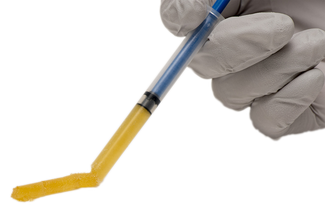Optium® DBM Gel

Optium DBM®
Optimally demineralized1-4 gel provides a natural osteoconductive scaffold and osteoinductive potential to encourage bone healing and fusion.
- Osteoinductive Potential: Demineralized using proprietary PAD® technology that targets optimal residual calcium levels of 1-4% without compromising the grafts inherent osteoconductive properties or osteoinductive potential.1-4
- Excellent Handling Properties: Moldable putty and flowable gel are designed to conform to the defect site.
- Osteoconductive: Natural bone matrix facilitates cell attachment and proliferation.5
- Sterile: Sterilized using proprietary and patented Allowash XG® technology which provides a sterility assurance level of 10-6, without compromising the graft’s inherent osteoconductive properties or osteoinductive potential.6,7
- Proven Carrier: DBMs using glycerol as a carrier have extensive published clinical history and have proven safe and effective in bone void filling applications.8-16
- Final Lot Testing: Every donor lot of final graft material is tested for osteoinductive potential using the nude rodent assay developed by Marshal Urist.
- Ready-to-Use: No rehydration or thawing required, saving valuable operating room time.
- Versatile: Available as putty or gel in multiple volumes to meet surgical needs.
Clinical Application
Fill bony voids or gaps of the skeletal system (e.g. extremities, spine, and pelvis) that are not intrinsic to the stability of the bony structure
- Joint Reconstruction and Revision
- Trauma
- Spine
| Description | Sizing | |
|---|---|---|
| TGEL01 | Gel (Particulate DBM & Glycerol) | 1 cc |
| TGEL05 | Gel (Particulate DBM & Glycerol) | 5 cc |
| TGEL10 | Gel (Particulate DBM & Glycerol) | 10 cc |
References
- Zhang M, Powers R, Wolfinbarger L. (1997). Effect(s) of demineralization process on the osteoinductivity of demineralized bone matrix. J Periodontol, 68:1085-1092.
- Turonis JW, McPherson JC 3rd, Cuening MF. (2006). The affects of residual calcium in decalcified freeze-dried bone allograft in a critical-sized defect in the Rattus norvegicus calvarium. J Oral Implantol. 32(2), 55-62.
- Herold RW, Pashley DH, Cuening MF. (2002). Effects of varying degrees of allograft decalcification on the cultured porcine osteoclast cells. J Periodontol, 72(2), 213-219.
- Mott DA, Mailhot J, Cuenin MF, Sharawy M, Borke J. (2002). Enhancement of osteoblast proliferation in vitro by selective enrichment of demineralized freeze-dried bone allograft with specific growth factors. J Oral Implantiol, 28(2), 57-66.
- Cornell C, Lane J. Current understanding of osteoconduction in bone regeneration. Clin Orthop Relat Res. 1998 Oct; (355 Suppl): S267-73.
- Eisenlohr LM. “Allograft Tissue Sterilization Using Allowash XG®.” 2007 Bio-Implants Brief.
- Block JE. The Impact of Irradiation on the Microbiological Safety, Biomechanical Properties, and Clinical Performance of Musculoskeletal Allografts [white paper]. 2004.
- Cammisa FP, Jr., Lowery G, Garfin SR, et al. Two-Year Fusion Rate Equivalency Between Grafton® DBM Gel and Autograft in Posterolateral Spine Fusion. Spine 2004;29:660-629.
- Kang J, An H, Hilibrand A, Yoon ST, Kavanagh E, Boden S. Grafton and local bone have comparable outcomes to iliac crest bone in instrumented single-level lumbar fusions. Spine (Phila Pa 1976);37(12):1083-91
- Park HW, Lee JK, Moon SJ, Seo SK, Lee JH, Kim SH. The efficacy of the synthetic interbody cage and Grafton for anterior cervical fusion. Spine (Phila Pa 1976). 2009;34(17):E591-5
- Sassard WR, Eidman DK, Gray PM, et al. Augmenting local bone with Grafton demineralized bone matrix for posterolateral lumbar spine fusion: avoiding second site autologous bone harvest. Orthopedics 2000;23:1059-64; discussion 64-5.
- Thalgott JS, Giuffre JM, Fritts K, Timlin M, Klezl Z. Instrumented posterolateral lumbar fusion using coralline hydroxyapatite with or without demineralized bone matrix, as an adjunct to autologous bone. Spine J. 2001;1(2):131-7
- Weinzapfel B, Son-Hing JP, Armstrong DG, et al. Fusion Rates After Thoracoscopic Release and Bone Graft Substitutes in Idiopathic Scoliosis Spine 2008;33:1079-1083.
- Hamadouche M, Karoubi M, Dumaine V, Courpied J. The use of fibre-based demineralised bone matrix in major acetabular reconstruction: surgical technique and reconstruction results. Int Orthop. 2011;35:283-288
- Pieske O, Wittmann A, Zaspel J, et al. Autologous bone graft versus demineralized bone matrix in internal fixation of long bones. J Trauma Manag Outcomes, 2009;3:11
- Thordarson DB, Kuehn S. Use of demineralized bone matrix in ankle/hindfoot fusion. Foot Ankle Int. 2003;24(7):557-60
- Hunt, D.G. & Chandler, C & Ulrich, D.A. & Poska, R & Montero, A. (2013). USP council of experts USP controlled room temperature range expansion. Pharmacopeial Forum. 39
